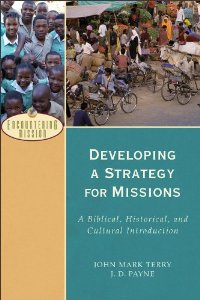 Lord willing–this September–Baker will release the book Developing a Strategy for Missions: A Biblical, Historical, and Cultural Introduction. I am delighted to share this news with you. John Mark Terry and I co-authored this book as a part of the Encountering Mission series. In this post, I want to give you a bit of the story behind the work and a quick glimpse into its contents.
Lord willing–this September–Baker will release the book Developing a Strategy for Missions: A Biblical, Historical, and Cultural Introduction. I am delighted to share this news with you. John Mark Terry and I co-authored this book as a part of the Encountering Mission series. In this post, I want to give you a bit of the story behind the work and a quick glimpse into its contents.
Mark has authored and edited several books (his most recent, co-edited with Robert Plummer, Paul’s Missionary Methods: In His Time and Ours), and spent many years as a professor and also serving as a missionary in Asian contexts. I first met Mark when I was a seminary student.
The origin of Developing a Strategy for Missions is found at the end of the twentieth century when I was one of Mark’s doctoral students. I remember on the first day of his Ph.D. seminar, “World Evangelization Strategies,” that he addressed the need for good literature on missionary strategy. After hearing this information, I started thinking about writing such a book. Years later, I was on a flight to Europe and was pondering this literary need and the thought of inviting Mark to co-author such a work. When I returned to the States and shared this thought with him, we spoke with the series editor, Scott Moreau. He and Baker liked the idea, so Mark and I went to work.
We divided the writing responsibilities. Mark wrote chapters 6-15, 17, 18 and I took chapters 1-5, 16, 19-27. Following the structure of the series, we included numerous tables, diagrams, box inserts, sidebars, and discussion questions.
Very few books on missionary strategy have been published in the United States, particularly in the last twenty years. In 1980, Edward Dayton and David Fraser published Planning Strategies for World Evangelization (A concise revision was published in 1990.). This outstanding, yet behemoth-of-a-book, is a classic in missionary literature. We have been influenced greatly by this work and such is evident in Developing a Strategy for Missions. While we are not equating our work with their work, we did want to produce a comprehensive strategy book for a new generation. We also desired to strike a healthy balance between writing an academic work (Baker Academic is overseeing this project) and writing a field-oriented work (after all, strategy development is practical by nature). I believe we accomplished our goals for this project.
The book is divided into four sections: 1) Theological/Missiological; 2) Historical; 3) Cultural; and 4) Practical. The Table of Contents follows:
Preface
1. Strategy Defined
2. The Crafting of Mission Strategy
3. Contemporary Objections to Missionary Strategy
4. Strategic Planning in Biblical Perspective
5. Missiological Principles for Strategy Development
6. The Apostle Paul’s Missionary Strategy
7. Missions Strategy in the Early Church
8. Roman Catholic Strategy
9. Pioneer Protestant Strategies
10. Faith Missions Strategy
11. Mission Strategies on the American Frontier
12. The Indigenous Mission Strategy
13. The Church Growth Movement
14. Frontier Strategies
15. Contextualization Strategies
16. Understanding Cultural Research
17. Developing a People-Group Profile
18. Developing a Communication Strategy
19. Discerning Receptivity
20. Discerning Need
21. Visioning for the Future
22. Forming a Team
23. Assessing the Resources
24. Setting Goals
25. Choosing Appropriate Methods
26. Execution
27. Evaluation
Bibliography
Scripture Index
Subject Index
If you are looking for a resource to assist your students, church, agency, or team in developing a strategy for domestic and international disciple making, then I want to encourage you to get a copy of this book. But, remember: Even the best strategies remain as theory until application is made to the field. Don’t get this book and shelve it; get it and apply it!
While I know that prices fluctuate, at the time of this post, Amazon has a very good pre-order price–the cheapest I’ve seen yet.

Hi JD! Your books have been very helpful to me! I’m looking forward to reading this one. Will it be available on Kindle once it is released?
Thanks so much, Jack! You are kind. As far as I know, it will be on Kindle.
The “need for speed,” if allowed to become the controlling factor behind missionary strategy and on-field decisions, can lead (and, in some cases, has led) missionaries to carry out their work in ways that are not totally transparent. While not unsympathetic to the validity of creative access strategies in certain contexts, Sills warns of communicating in such a way that, when discovered, may be interpreted as deceptive and put a stumbling block in front of disillusioned evangelistic contacts and new believers. Also, while defending the need for critical cultural contextualization, he censures methods that are not totally aboveboard, and often involve compromise on gospel essentials.
Pingback: Missiologically Thinking » Developing a Strategy for Missions